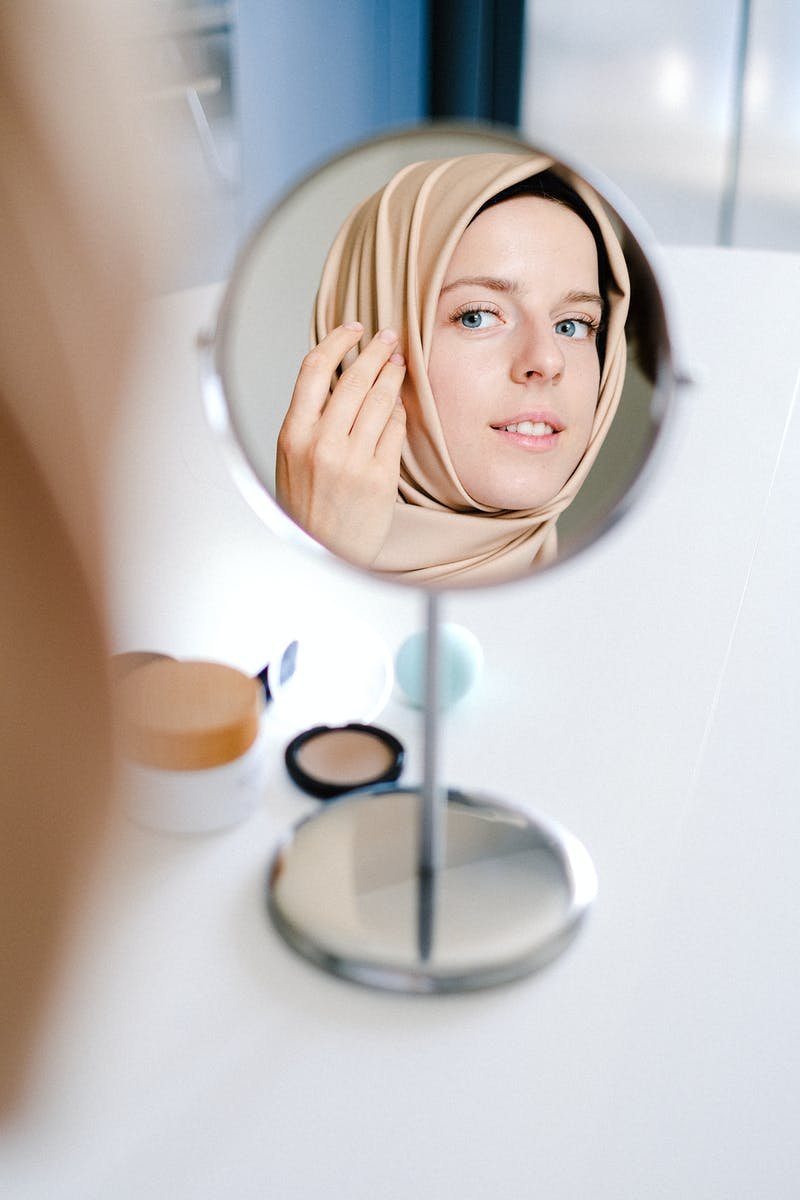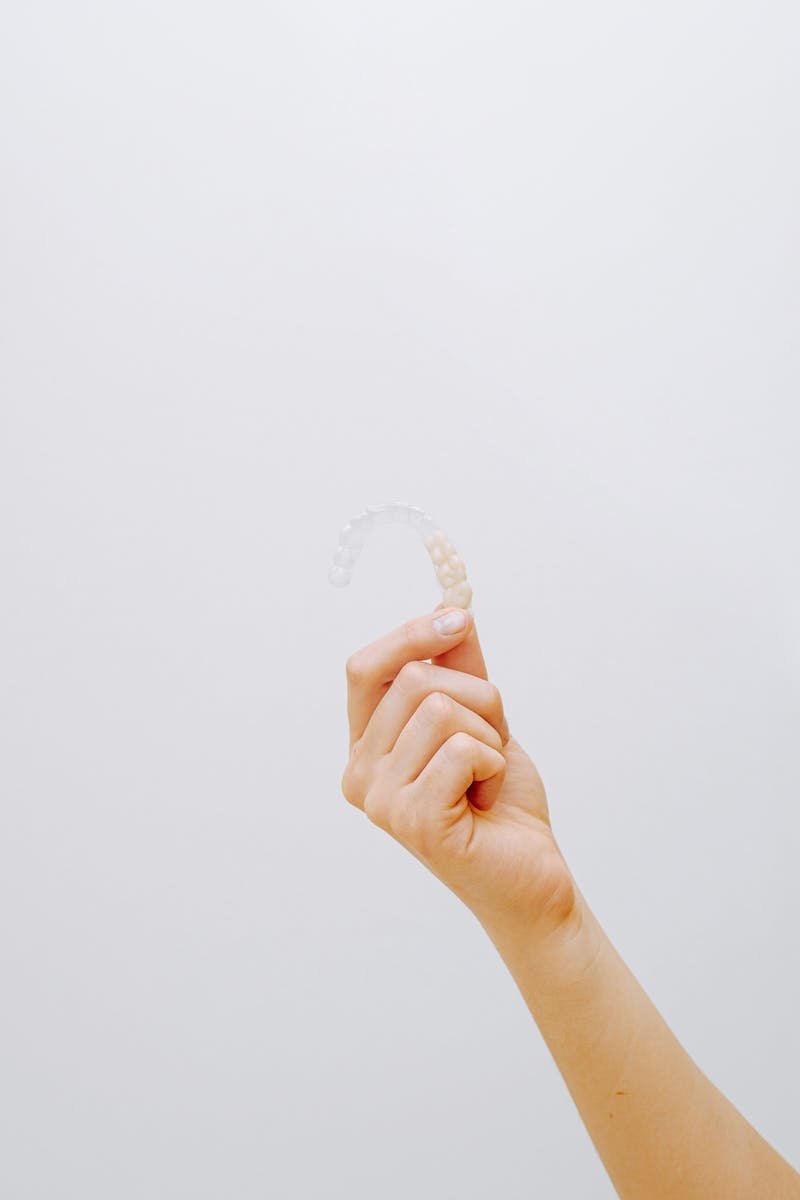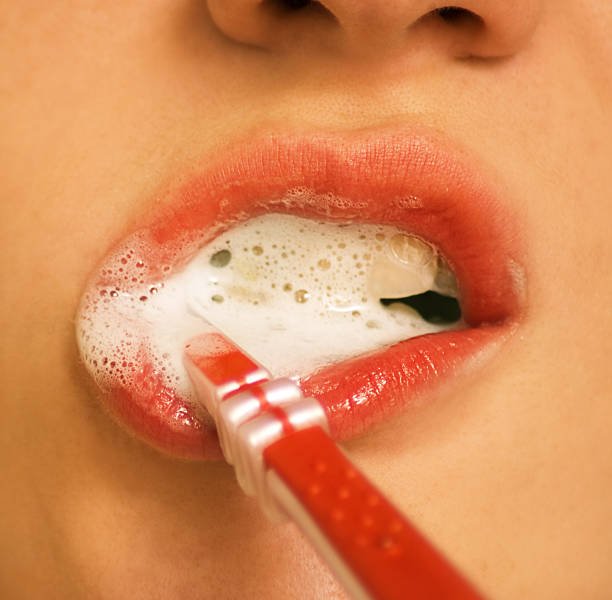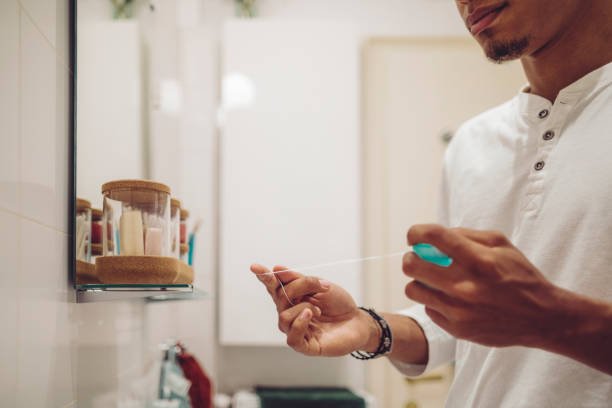Avoid these common habits to protect your teeth!
We all develop a number of bad habits, but some habits that you don’t think are too bad can actually have a HUGE impact on your oral health.
The following are some common habbits that could impact your dental health:
Biting Your Nails
Biting one's fingernails is a very widespread habit. Your oral health, though, could be harmed by this behavior. You probably pick up germs on your hands throughout the course of the day. Placing your fingers close to a small wound in your mouth could result in an infection. Additionally, over time, the enamel and gums in your mouth can be harmed by your fingernails.
Tobacco Chewing or Smoking
Numerous people continue to use tobacco products every day despite a wealth of evidence indicating they are bad for your overall health. In addition to raising the risk of tooth decay, smoking occasionally raises the chance of oral cancer. Additionally, smoking has a detrimental effect on the appearance of your teeth, making them appear stained and discolored.
Opening Packages with Your Teeth
You might be tempted to use your teeth to pry open packages if scissors aren't there. Even though it might seem safe, using your teeth to tear open plastic packaging can hurt your gums and even shatter some of your teeth.
Having Too Many Acidic Drinks
Your oral health won't suffer if you have the occasional glass of wine or orange juice; in fact, these and other acidic drinks have certain health advantages. However, excessive use of acidic beverages can weaken your enamel and hasten the decaying process of your teeth, endangering the general health of your mouth.
Ice Chewing
Although it might appear harmless, it is bad for your teeth to chew ice. Your chance of chipping your tooth enamel increases when you chew ice. Your teeth are more susceptible to infection and decay when your enamel is compromised.
Teeth Grinding
Some people clench their teeth as they sleep, while others do so when they are stressed. In either instance, grinding your teeth increases the rate of enamel erosion and can result in chips. To get help managing the problem in this case, speak with your dental healthcare professional. If you grind your teeth, your dentist might be able to offer oral appliances.
Take Care of Your Dental Health
Now that you're aware of the negative habits that might damage your dental health, think about finding ways to decrease or get rid of them. The best method to cope with any unhealthy behaviors that could harm your tooth health is by going to the dentist.
Do I have a cavity?
What is a cavity and do I have one?
A dental cavity is a hole that forms in your tooth after the enamel is damaged. Plaque on the teeth is typical in modest amounts, but it should not stay on the teeth for more than two days. It eventually converts into tartar after two days, which changes sugar into acid, which damages your enamel.
Are you unsure whether you have cavities? Here are a few things to keep an eye out for:
1. Constant toothaches
If you're having trouble sleeping or accomplishing other duties because of a persistent toothache, you may have a cavity. When the damaged tooth comes into touch with anything, from hot or cold liquids to food, the pain is often exacerbated.
When you have cavities, food particles can become caught inside your tooth, exacerbating the pain.
2. Mouth odor
Cavities can occasionally be detected by bad breath. In fact, many people experience a sour taste in their mouth along with poor breath. Food particles often adhere to cavities, making them ideal breeding grounds for germs.
If your dental hygiene practices do not change, the acids that bacteria make in cavities might harm your gums and lead to gingivitis. If you realize that your breath smells horrible all of the time, it's time to see the dentist.
Bad breath can be caused by a variety of oral health conditions. Whatever problem you're having, your dentist knows how to solve it.
3. Brushing causes bleeding
People who have cavities frequently bleed while brushing their teeth. Cavities can grow deep enough in your teeth to reach the nerves, which sometimes bleed when agitated. Gum disease can also cause bleeding gums. In any case, you should make an appointment with your dentist right away.
4. Teeth with visible holes
When you stand in front of a mirror, depending on the placement of the cavity, you may be able to see it. If you think you have cavities, you can also feel them with your finger. A personal inspection of your mouth is recommended if you are experiencing other cavities symptoms such as foul breath or toothaches.
Conclusion
These are just a handful of the signs and symptoms of dental cavities. While it is critical to understand what these symptoms signify, seeing a dentist is even more crucial. A dentist will assist you in determining your alternatives.
All of your veneer questions answered !
You might have thought about getting veneers if your teeth have serious staining or discolouration that cannot be improved with whitening procedures. Dental veneers are a common solution for those who want to whiten, straighten, or otherwise improve their smiles since they can treat a variety of aesthetic dental concerns. Because of this, we've gathered the most frequently asked questions concerning dental veneers and their responses in one place.
How Do Dental Veneers Work?
Thin, tooth-colored shells called dental veneers are bonded to the front of your tooth or teeth. The shells can be constructed of composite bonding but are frequently composed of resilient porcelain material.
Am I a Good Veneer Candidate?
You have a better chance of being a good candidate for porcelain veneers if you don't have gum disease or cavities. However, if you frequently clench or grind your teeth, you might need to wear a nightguard to protect your veneers. It is vital to speak with your dentist before undergoing any dental procedure to determine whether veneers are the best option for you.
Will Veneers Sensitize My Teeth?
A thin layer of your tooth enamel must be removed in order to make way for porcelain veneers. Your teeth could feel sensitive afterward. Fortunately, while you wait for your permanent set to arrive from the lab, you will wear temporary veneers. This lessens some of the sensitivity in the teeth. Once your permanent veneers are in place, your sensitivity should disappear.
Can veneers be reversed?
Because your dentist needs to remove a thin layer of your enamel, traditional porcelain veneers are not reversible. However, other veneers, like Lumineers, don't need the teeth to be prepped, making them more changeable. These alternatives, however, are not as strong or attractive as conventional veneers.
They last for how long?
Your habits and oral hygiene regimen will affect how long your dental veneers last. Dental veneers should last 15 to 25 years on average before needing to be changed.
Are Porcelain Veneers Covered by Insurance?
Your dental insurance coverage will determine everything. The majority of dental insurance plans won't pay for veneers if they are only used for aesthetic purposes. However, if they're intended to repair broken teeth, your insurance may cover some of the cost of your care.
What can I eat with veneers?
Yes, you are able to maintain your normal diet while sporting porcelain veneers. But you shouldn't bite your nails, chew on ice, or chew on anything else that isn't food.
Do porcelain Veneers Stain?
Because porcelain veneers are stain-resistant, you can indulge in as much coffee and red wine without worrying about staining your smile. The teeth beneath the dental veneers can still become stained. Make sure to rinse your mouth out with water after consuming anything with a lot of color that can stain your teeth.
Is the Procedure Painful?
No. To lessen any pain during the tooth preparation procedure, dentists use a local anesthetic. The veneers are bonded to your teeth painlessly.
How much time does the procedure require?
The number of veneers you're getting will determine how long the surgery takes. Your teeth are cleaned and impressions are taken at the first session, and the veneers are bonded to your teeth during the second appointment. The entire operation often lasts a few hours.
Conclusion
Dental veneers might be the answer if you're looking for a way to restore teeth that are stained, broken, cracked, or just slightly out of place. Make an appointment with the dentist to learn more about veneers and to move one step closer to the smile of your dreams.
What's the Difference Between Dental Implant Placement and Implant Restoration?
Missing teeth can have a negative impact on your overall health. They can create crooked teeth, harm your gums and jaws, and even change the shape of your face. Missing teeth can harm your dental health as well as influence the appearance of your smile and your self-confidence.
Visiting your dentist to explore your choices for replacing missing teeth is the best way to go. Dental implants are a popular choice among patients who want a long-lasting, natural-looking replacement for lost teeth. Implant insertion and implant restoration are the two stages of a dental implant procedure. What's the difference between the two, and do you need both? Continue reading to discover out.
What Is a Dental Implant and How Do I Get One?
A dental implant is a surgically implanted artificial tooth root that serves as a basis for fixed or removable replacement teeth. There are three parts to a dental implant:
An implant is a root for replacement teeth that is anchored to your jawbone.
The dental prosthetic is held in place by an abutment that is joined to the implant.
The visible element of the implant repair is a dental prosthetic, such as a bridge or crown. Porcelain dental prosthesis have a more natural appearance.
Because dental implants are designed to connect with your bone, they can survive for years if properly cared for. They have a number of advantages, including reducing cavities and bone loss, enhancing speech and biting force, supporting neighbouring teeth, and boosting your smile's appearance.
Installation of Dental Implants
The insertion of dental implants is the initial stage in the treatment process. To build a stable foundation for a dental prosthetic, dental implants require sufficient jawbone density. If your jaw is too thin, you may need a bone graft before surgery to provide the implant a stronger foundation.
Your dentist will access your jawbone via the gums to attach the implant during the procedure. Following the treatment, your dentist may recommend removable dental prosthesis to help with bite stability and look while you heal. Following implant implantation, it takes three to six weeks for the body to recuperate. The jawbone grows around the implant and merges with it during this time, a process known as osseointegration.
Implant Restoration
You can return to your dentist for an implant repair after your implant has healed. Under anesthetic, your dentist or oral surgeon will connect the abutment to the implant. Your gums will need to recover for two weeks before your dental prosthetic may be attached. Your replacement teeth will be custom-made for you based on the number of missing teeth, their size, and the color of your existing teeth. The abutment is subsequently connected to your replacement tooth or teeth, completing the implant repair.
Conclusion
Treatment with dental implants can completely transform your life, allowing you to smile and communicate confidently in social situations. It can also be a long-term answer to the health issues that come with missing teeth. Dental implants can provide a range of benefits and enhance your overall quality of life if you have lost teeth due to disease or decay.
Which dental bridge should I get?
A dental bridge is a prosthesis that spans the gap between two teeth. Bridges are used to secure prosthetic teeth in place by cementing a crown on both sides of the missing tooth.
A dental bridge is one of the greatest non-invasive solutions to replace a single tooth or many missing teeth, if you have one or more missing teeth. However, you should see your dentist to have your mouth evaluated to determine which type of dental bridge you should use to replace your missing tooth.
Dental bridges, like most prosthetic dental devices, are built out of a wide variety of materials. Porcelain and ceramic bridges are the most popular because they closely resemble real teeth and can be color-matched, making them difficult to detect.
Metal alloy bridges are the least expensive alternative, but they are not as popular as porcelain or ceramic bridges because they do not appear natural and are easily seen.
Different types of dental bridges
Traditional bridge
This is the most popular type of dental bridge . When you have natural teeth on both sides of the gap where your tooth used to be, this bridge is used. Crowns are placed on the teeth that are next to the gap left by the missing tooth to secure the prosthetic tooth in place.
Traditional dental bridges can last for years before needing to be rebuilt.
Maryland bridge
When patients do not want dental crowns to hold the prosthetic tooth in place, this form of dental bridge is a conservative alternative to a standard bridge. A metal or porcelain framework is bonded to the back of the surrounding teeth during the treatment.
Because the prosthetic tooth is held in place by a frame, it is less durable than a standard bridge, which uses cement to hold the tooth in place.
Cantilever Bridge
A cantilever bridge, like a standard dental bridge, uses cement to hold the artificial tooth in place. However in this approach, one of the surrounding teeth is used to hold the artificial tooth in place.
Implant-supported Bridge
Implant supported bridges can be used to replace numerous missing teeth at once, and have become popular for restoring missing teeth. Your dentist will replace your lost tooth with a dental implant, which will keep the bridge in place instead of crowns or frames.
Since it is the most durable type of dental bridge, this operation is quite popular. This is because the implants are linked to your jaw bone and can last a lifetime if properly cared for. You won't have to worry about the bridge failing or your artificial teeth sliding out of position.
Conclusion
Dental bridges serve to restore your smile and confidence by replacing lost or damaged teeth. If you have lost teeth and wish to replace them, talk to your dentist about which dental bridge is the best option for you.
What happens during an Invisalign Appointment?
If you're reading this, you're probably thinking about getting Invisalign treatment. This article will tell you all you need to know about clear aligners and how they work.
Invisalign is a clear aligner that allows patients to treat their teeth alignment issues in a more discreet manner. It entails the use of transparent trays to gradually shift teeth into a better position. At the commencement of treatment, patients are given a number of trays, each of which moves the patient's teeth 0.33 millimeters closer to the target alignment. The tray is then replaced with one that moves the person's teeth closer to their final position.
It can be used to rectify problems such a bad bite, crooked teeth, and misaligned teeth. Bite alignment issues can cause a range of uncomfortable symptoms, including:
Soreness
Headaches
Snoring
Gum problems
Jaw pain\sWorn down teeth
Tooth decay
What to Expect at an Invisalign Consultation
Patients interested in Invisalign orthodontic treatment should anticipate to go through the following steps:
1. A discussion
The dentist will explain how the therapy works at the initial visit. They will make an impression of the patient's mouth and take photographs of it. These images are utilized to better understand their dental structure.
Digital imaging technology is utilized to create an impression of the patient's mouth if the dentist believes the patient is a good candidate for Invisalign. It results in more accurate scans that can be sent to an Invisalign lab right away. The lab makes the aligners and sends them back to the dentist in approximately three weeks.
2. Aligners are tested
The patient gets to try out their first pair of aligners on their second appointment. Attachments will be placed on their teeth as well. These add-ons assist in keeping the aligners in place. It creates holds and pushes to accommodate natural movements that occur when wearing the gadget. Attachments are difficult to notice because the operation is painless and the materials utilized are tooth-colored. Attachments are easily removed and do not harm teeth.
For the same reason, a surgery known as interproximal reduction could be used. To make place for the aligners, some teeth must be sanded. Although the surgery is painless, anesthetics are used. The patient's condition will be improved.
If everything appears good, the patient will be issued their aligner trays.
3. Treatment
When the patient receives their aligner trays, they must wear them for at least 22 hours per day. Only take your aligners out for meals or oral hygiene.
Follow-up appointments will be made for the patient to check their development. Changes to the attachments or the addition of more trays to the treatment may be made during these appointments.
4. Finishing your treatment
The dentist will analyze the patient's results after they have completed the therapy. Attachments will be removed once the patient is happy, and retainers will be used instead. These aid in maintaining the new location of their teeth.
There's never been a more nuanced approach to treatment.
Thanks to Invisalign, you can now correct orthodontic difficulties without the need of metal braces that resemble railroad tracks on your teeth. To get started with your treatment, come to our Brooklyn office.
5 Step Impeccable Oral Hygiene Routine
While most people are aware of the benefits of good oral cleanliness, not everyone follows a good dental hygiene routine. The key to success is consistency, so start small and develop positive, long-term habits. These five suggestions will assist you in developing a practical and effective oral hygiene routine:
1. Schedule dental appointments on a regular basis.
Your dentist can detect and prevent oral health issues before they become serious if you have frequent dental check-ups.
We recommend that you visit the dentist at least twice a year. Oral exams, cleanings, fluoride treatment, and sealants are all part of a regular dentist visit. These consultations also provide you with helpful advice for at-home dental care. Your dentist will examine your teeth, gums, and jaws and give recommendations..
2. Establish a Comprehensive Home Care Program
Taking appropriate care of your teeth and gums entails more than just brushing and flossing. It's also crucial to brush your teeth properly, spending at least two minutes doing so and avoiding brushing too hard. Maintaining oral hygiene and overall wellness also includes cleaning your tongue. A scraper is useful for removing microorganisms from this essential organ. Flossing is an important part of your oral hygiene routine. Flossing everyday removes food particles lodged between your teeth and reduces bacteria accumulation, which can lead to dental decay. Rinsing with mouthwash, eating sugar-free gum, and drinking enough water are all other ways to take care of your oral health at home.
3. Eat a Balanced Diet
Your entire health and wellness, as well as the health of your teeth, gums, and jaws, are influenced by the foods you eat. Dental professionals, for example, recommend including crunchy vegetables and fruits in your diet. These meals are high in fiber, which aids in the activation of your jaw muscles.
Acidic, sticky, sweet, or high-carbohydrate diets are more likely to hasten tooth decay. Sugary foods also contain starches, which serve as a breeding ground for microorganisms that are detrimental to humans. While you don't have to exclude these foods entirely from your diet, you should consume them in moderation. Brushing or flossing your teeth after each meal can also help prevent tooth decay.
4. Purchase high-quality dental supplies
Choosing the best dental treatment might be difficult with so many options available. It's critical to be honest with your dentist about your dental health objectives, concerns, and questions. They can suggest products and services that are tailored to your specific dental requirements and provide the best value for your money.
The advise of your dentist can be a good place to start when it comes to finding the brands and products that perform best for you. When looking for new oral health products, look for brands that have gained the American Dental Association's Seal of Acceptance (ADA).
5. Avoid Unhealthy Habits
Several behaviours might have a negative impact on your oral health. Clenching and grinding your teeth are two of them, and they can lead to muscle soreness, migraines, jaw injuries, and chipped teeth. Bruxism is the term for this unconscious clenching or grinding, which can be recognized and treated by your dentist.
Smoking is one of the most damaging habits you may have when it comes to your oral health. Smoking not only discolors teeth and weakens gums, but it also raises the risk of developing oral, throat, and lung cancer.
Despite the fact that your teeth are tough, you should avoid habits that wear down your enamel prematurely. Dental professionals advise against biting your nails or using your teeth as a bottle opener. Also, avoid dangerous dental hygiene behaviors like brushing your teeth too hard, which can destroy your gum line.
Conclusion
While it may take some time for your dental hygiene regimen to become second nature, good dental hygiene practices will enhance your oral health and overall well-being in the long run. By addressing tooth decay and other disorders as early as possible, preventive dental care can save you a lot of time, money, and agony. You maintain your best dental health, make sure to see your dentist on a regular basis.
Why You Shouldn’t Wait to Restore Damaged Teeth
Injuries, tooth decay, and gum disease can all destroy your smile and have a negative impact on your overall oral health. Don’t worry, if you have damaged teeth, there are various restoration treatment choices available to you.
A broken tooth can make it difficult to chew food properly and create speech problems. Also, if the injured tooth causes a gap in your grin, the neighboring teeth may shift and become crooked. Simple dental operations like crowns and root canals, on the other hand, can help restore your teeth and prevent additional damage.
There is a remedy for you, no matter how badly your tooth has been damaged. If your tooth is fractured, chipped, or has a significant cavity, you should seek treatment as soon as possible. The sooner a broken tooth is repaired or replaced, the better. Here are a few reasons why you shouldn't put off having your damaged tooth restored:
1. Pain Relief
Any discomfort you may be experiencing can be alleviated by seeking dental care as soon as possible. An infected tooth with a crack or deep hollow might cause a terrible toothache. Sharp edges on your teeth, even from minor cracks and damage to the enamel, can cut your lips, tongue, and gums. You will avoid pain and discomfort, as well as subsequent oral health difficulties, if you restore your tooth as soon as possible.
2. Insurance and Payment Plans
Dental insurance covers the majority of treatments for broken or decayed teeth, making fillings and restorations more affordable. Many dentists offer low-interest financing and payment plans to keep treatments within your budget, even if you don't have dental insurance or your coverage isn't enough to cover the entire procedure.
3. Waiting too long can lead to a recurrence of oral health problems
If you don't repair a damaged tooth straight away, it may be more difficult to do so later. A simple root canal or a dental crown are not always enough to repair advanced tooth disease or decay. A tooth extraction and dental prosthesis, such as an implant-supported crown, may be required. You have a better chance of saving your teeth if you get treatment for dental problems as soon as possible.
4. You Save Time and Money With Early Detection and Restoration
Replacing lost teeth with dental implants is far more expensive than restoring a damaged tooth with a dental crown or filling. Similarly, removing and replacing a tooth is more time-consuming and intrusive than root canal and crown therapy. Early detection and treatment of a damaged tooth can save you a lot of time and money.
Restore your smile as quickly as possible.
A broken tooth can have a negative impact on your self-esteem, dental health, and general health. Furthermore, tooth decay and other oral health problems can quickly turn into infections, increasing your chances of losing teeth. Don't wait to restore a tooth if you feel it's damaged or has a cavity! Visit your dentist as soon as possible to get the treatment you require.
Your gum health is important - here are 5 tips to maintain healthy gums.
When you think of your oral health,you think of your teeth. How white they are, how straight they are, if you have a cavity, etc. But when you are taking proper care of your mouth you need to give your gums the same amount of love as you give your teeth.
Your gums are equally as important to take care of! Gum disease causes red, swollen gums, which can lead to loose teeth and infection pockets between your teeth and gums.
Gum disease can be avoided by being proactive and taking good care of your gums. For healthier gums, follow these five guidelines:
1. Brush your teeth thoroughly at least twice a day.
The first line of defense against gum disease is brushing your teeth at least twice a day. This is because it aids in the removal of plaque from your teeth. Brush your teeth with a soft-bristled toothbrush and fluoride toothpaste. Brush carefully with short strokes while holding your toothbrush at a 45-degree angle toward your gums. Brush the outside surfaces of your teeth with short, back-and-forth strokes, and the inner upper-front teeth with short, downward strokes.
Pro tip: Don't wait until the bristles of your toothbrush are frayed before replacing it. You should replace your toothbrush every three to four months, and you should also replace it if you've been sick.
2. Floss at least once a day.
Flossing at least once a day is essential for preventing gum disease. It cleans food and plaque from between your teeth and along your gum line, reducing the chance of tartar formation.
Tartar is bacteria that builds up on the teeth and hardens; it cannot be eliminated by brushing and must be removed by a dentist. Tartar can cause gum disease if it is allowed to form.
Use soft floss, dental picks, or flossers if flossing is difficult or uncomfortable for you.
See this blog here on how to properly floss.
3. Visit the dentist on a regular basis.
Professional cleanings are the only way to remove tartar from your teeth, therefore go to the dentist on a regular basis. These visits also allow your dentist to detect gum disease at its earliest stage, when it's easiest to cure.
Make an appointment with your dentist at least twice a year. If you have oral health problems, you may require more regular checkups.
4. Use mouthwash on a daily basis.
Mouthwash has a number of oral health advantages. Plaque and tartar bacteria that cause gum disease can be killed by rinsing with an anti-gingivitis mouthwash on a daily basis.
It doesn't matter if you use mouthwash before or after brushing; the important thing is that you use it. Simply swish it around in your mouth for 30-60 seconds.
5. Give up smoking.
Cigarette smoking impairs your immune system and increases your risk of gum disease. It may also impede blood flow to the gums by interfering with the regular function of gum tissue cells.
Cigars, smokeless tobacco, and other tobacco products are all bad for your gums and mouth.
Conclusion
Gum disease is a serious condition that can harm your teeth, gums, and general oral health. You can lower your risk of gum disease and improve your dental health by following these guidelines.
Plaque vs. Tartar: What's the difference and how to avoid it
While talking to your dentist, shopping for toothpaste, or even watching a tv commercial you cannot avoid hearing about the importance of tooth enamel. Enamel coats your teeth, making them strong and durable. Your tooth enamel makes your teeth able to withstand wear and tear for many years. Tooth enamel is very important which is why you should protect it. Going to regular dental cleaning appointments allows for your dentist and hygienist to remove plaque and tartar.
If you allow plaque to build up and harden on your tooth enamel, it will increase your chance of acquiring tartar and other oral health problems (like gum disease).
Plaque and tartar are the enemies of your tooth enamel, but what are the differences between them?
What Exactly Is Plaque?
Plaque is a soft, sticky film that forms on your teeth as bacteria, saliva, and food combine together. Plaque, according to the American Dental Association (ADA), contains over 500 bacteria species, some of which are beneficial to your dental health and others which are harmful.
After you drink or eat, harmful bacteria usually create acids, especially if you ingest sugary foods or beverages. These acids then destroy your teeth's enamel, causing more significant dental and overall health problems. Plaque can harden on your teeth and grow into tartar if left untreated, causing your gums to swell and become sensitive - an early sign of gum or periodontal disease.
The following are some of the most prevalent plaque symptoms:
Bad Breath
Your teeth feel like they have a film on them
Gums that are tender, swollen, or red and may bleed when brushed
What Exactly Is Tartar?
When plaque remains on your teeth for an extended period of time, it interacts with minerals in your saliva to form tartar. Tartar hardens on the outside of your teeth or collects below the gum line, making it more difficult to clean them.
To prevent periodontal disease, a dental health practitioner (hygienist) or dentist must remove tartar below the gumline as soon as possible. Periodontal disease, often known as gingivitis, causes swollen, bleeding, or red gums in its early stages.
Gingivitis can proceed to periodontitis if left untreated, causing your gums to peel away from your teeth. In more severe cases, it may cause your teeth to loosen and possibly fall out over time.
The following are some of the most prevalent tartar symptoms:
Gum tissue is swollen
You have crusty yellow or brown-colored deposits on your teeth
Gums that are prone to bleeding
Prevention and Treatment
Plaque can be removed from your teeth by brushing and flossing on a daily basis. Tartar, on the other hand, must be removed by a dental professional during cleanings.
Here are some tips for preventing plaque and tartar accumulation:
Every six months, go to the dentist for a routine checkup and cleaning
Limit your intake of sugary foods and beverages, and brush your teeth afterward
A dentist may recommend alternative treatment options, such as dental sealants and fluoride treatments, in addition to regular oral hygiene and expert cleanings
If you have a history of cavities, you should talk to your dentist about dental sealants. A sealant is a thin covering that is put to the backs of your teeth to help prevent cavities for two to four years.
Conclusion
Allowing plaque to linger on your teeth for an extended period of time can cause tartar to build, eroding your tooth enamel and increasing your risk of gum disease. Fortunately, you can prevent plaque accumulation and reduce the chance of tartar forming on your teeth and gums by practicing basic dental hygiene. More importantly, see a dental health expert for routine dental checkups and cleanings.
What can I eat after getting my tooth extracted?
"Will I be able to eat after the procedure?" This is one of the most often asked questions after tooth extractions.
Extractions, like many restorative dental treatments, may cause some oral discomfort and require a brief recovery period before you can resume your normal routine. However, you can continue to eat a variety of foods while healing from a tooth extraction.
After Tooth Extraction, What Should You Eat?
Only soft meals and beverages should be consumed for the first 24 hours after your tooth extraction. You can gradually return to your regular diet after a few days.
Stick to easy-to-chew foods in the days after your extraction. Cool foods like yogurt, ice cream, pudding, and Jell-O are simple to eat and can help soothe sore gums.
Scrambled eggs, mashed potatoes, porridge, or broth-based soups without huge chunks of meat are also great options. It's crucial to serve these items at room temperature, as hot foods might sabotage the healing process.
Here's a quick rundown of foods you can consume after having a tooth extracted:
Ice Cream
It's chilled and soft, which makes it easy to consume even if your mouth is sore. The cool temperature of ice cream also helps to reduce any natural swelling in the mouth.
It's crucial to pick your ice cream carefully. Soft serve is ideal for eating shortly after a tooth extraction because it requires less jaw movement. You should also avoid ice cream with solid sprinkles or mix-ins, and opt for a cup over a cone.
Cold Soup
Pureed soups that are cool or lukewarm are ideal to eat after tooth extraction. A smooth gazpacho is preferable to a lukewarm broth.Make sure the soup is as smooth as possible to avoid pain. A few small bits of pasta or vegetables can be added to the soup, but components that need proper chewing should be avoided.
Soup is a convenient post-surgery meal and it is high in nutrients and protein, promoting a speedy recovery.
Smoothies
Smoothies are a convenient method to consume fresh fruits following a tooth extraction. To make a drink with plenty of calcium, protein, and probiotics, blend frozen fruit with yogurt or kefir. Making your smoothie with yogurt or another dairy product lowers the acidity, making it less likely to bother sensitive gums.
Eggs Scrambled
After a tooth extraction, scrambled eggs are another good option, as long as they aren't too hot. Eggs are soft, abundant in protein, and require little chewing effort.
What to Avoid Eating
After oral surgery, you should avoid alcoholic beverages for at least 24 hours. If you're using severe pain relievers, don't drink alcohol until you've finished your medicine.
It's advisable to avoid hard, chewy, crunchy, or brittle foods like chips, almonds, and popcorn for roughly a week. While you're avoiding rough cuts of meat, dairy products might help you get more protein in your diet.
Conclusion
When considering tooth extraction, it's critical to consult with your dentist first. For a faster recovery, your dentist will explain what to expect during the extraction and provide you with full aftercare recommendations. Follow these instructions carefully and contact your dental office if you have any concerns or encounter any issues.
How To Get Used To Your Partial Dentures
Partial dentures are used to replace missing teeth when the majority of your natural teeth are still present. Even though dentures can help restore your smile, they can take some time to adjust to, particularly when it comes to eating.
Here are some tips to get used to your partial dentures :
Practice patience.
Eating with partial dentures is different than eating with natural teeth, so you'll need to adjust the way you eat for a while before you're comfortable. You must exercise patience, even though it may be frustrating at first.
Chewing with your natural teeth is easier, because your tooth's nerves send signals to your brain about how hard or soft to chew the food in your mouth. The prosthetic teeth with partial dentures do not have a connection to your brain, making chewing difficult at first.
Before going on to meats and harder things, start with soft foods like eggs, veggies, fish, and oatmeal. To make chewing easier, ensure that your meal is sliced into little bite-size pieces.
Do not use your front teeth.
Biting down on food will be tough if your partial dentures are in the front of your mouth, and this can damage your dentures. Instead of biting down on an apple with your front teeth, chop it into smaller pieces using a knife. This will make it easier to eat the meal while also preventing damage to your dentures.
Certain foods should be avoided.
There are certain meals you should avoid if you have partial dentures to avoid damaging them.
Among them are:
Peanuts/peanut butter: Peanut butter, like all sticky foods, should be avoided due to the harm it causes to dentures.
Steak: If you enjoy meat, this will be difficult to give up, but it is one of the sacrifices you must make if you wear dentures, as chewing tough meats can place a lot of strain on your teeth and the gums behind them, causing pain.
Hard candy: Biting down on hard candy can damage your dentures and cost you money; this does not mean you can't enjoy candy; it only means that if you must have hard candy, you should suck it rather than biting down on it with your dentures.
Also be aware of popcorn kernels because they can get stuck in your teeth, are difficult to remove, and can harm your partial dentures, especially if you bite an unpopped kernel by accident.
Regularly brush your dentures.
Dentures do not negate the importance of good oral hygiene. Brush and clean your partial dentures on a regular basis to reduce gum inflammation and decay of your remaining natural teeth.
Conclusion
It will take some getting used to eating with partial dentures, but if you follow the advice above, you should be able to eat most of the foods you used to eat before you got the dentures.
3 Dental Treatments To Get Before Your Wedding Day
You've already purchased your dream gown or suit/tuxedo. Your wedding day is set you booked the venue and entertainment. The only thing on your mind is how your smile will look on your special day. Before your wedding day, your dentist will help you smile with confidence for those beautiful photos.
There are numerous strategies to improve your grin, regardless of your degree of confidence. Before your wedding, try these three dental treatments:
Dental restorative procedures
Do you fear that your wedding day will be ruined by your chipped, cracked, or broken teeth? We can help you restore your smile with bonding, veneers, or crowns in time for your big day.
Bonding
The application of tooth-colored materials to the tooth surface is known as bonding. This closes any gaps between your teeth and improves the look of a chipped, fractured, or broken tooth.
Veneers
Veneers are thin shells that cover the teeth's front surfaces. If you have any chipped, worn out, ill-shaped, or permanently discoloured teeth, ask about Veneers. Veneers are custom-made to fit your teeth and can also be used to close gaps between them.
Crowns
Crowns, on the other hand, can be used as a fallback option if veneers aren't an option. These are "caps" that fit over the teeth and are tooth-shaped. Consider them crowns for your crooked teeth. Crowns restore the size and strength of your teeth in addition to improving their look.
2. Whitening
Teeth Whitening
Teeth whitening may be the dental treatment you require if your teeth are discolored. If your teeth are discolored in-office or take-home kits are the best option. Make sure you start well before your wedding date to achieve the color you desire.
3. Braces
Invisalign
Clear and invisible braces are now available thanks to advancements in dentistry. Invisalign is a great option if you wish to straighten your teeth, fill up the gaps between your teeth, or lessen the crowding of your teeth before your wedding day.
However, because this is not an overnight miracle, you must get started right now. Your engagement might be the cue and perfect time to get braces.
Thinking about a Smile Makeover ? Here are 4 things to consider first.
Let’s be honest, we are more self aware of what we look like during work now more than ever. You wake up, look in the mirror, brush your teeth and then spend your work days on zoom looking at yourself during meetings. Like thousands of others, you are now thinking about getting a smile makeover.
Here’s what you need to know before getting a smile makeover.
Your dental health is important
To determine the status of your teeth and the optimum cosmetic restoration for each tooth, X-rays and physical tests are required. We cannot start whitening your teeth if you have untreated cavities, because they can make whitening your teeth uncomfortable or create extreme sensitivity.
2. Shape and position of the teeth
The longevity of the smile makeover is greatly influenced by your teeth alignment. Crooked teeth, deep bites, and edge-to-edge bites are all more difficult to fix.
It is sometimes preferable to straighten the teeth first with braces or Invisalign to guarantee that the restorations last. A night guard may be recommended if you clench your teeth (see our other posts about TMJ).
3. The shade of your teeth
Veneers, crowns, and fillings all require the material to match the existing teeth in order for the smile to appear natural. If you are unhappy with the color of your teeth or are considering teeth whitening, it is best to whiten them until you are satisfied.
Crowns, veneers, and fillings do not whiten, therefore teeth whitening is recommended before a smile makeover. You cannot modify the color of the new restoration once you and your dentist agreed on the color, without replacing the restorations on the teeth. We recommend that you match your repairs to your preferred hue whenever possible.
4. Gum health is important
The way that the gums and jawbone fuse to the teeth play an important role in tooth durability. Periodontal disease loosens teeth, creates discomfort, and promotes tooth decay in hard-to-reach locations, making restoration more difficult. Damaged or loose teeth may need to be pulled in severe cases before a new smile can be created.
For a successful smile makeover, the gums and jawbone must be in good condition and need to be treated first.
In conclusion
You can have a gorgeous smile makeover regardless of your present oral condition. If you want to improve the appearance of your smile, schedule an appointment with us so we can get started.
5 Reasons You Should Go To The Dentist Regularly
Let’s face it you want strong and healthy teeth but you , like many others, don’t like to schedule frequent dental checkups. You might think that you don’t need regular dental cleaning visits, but they are essential for healthy and beautiful teeth.
In this post, we'll look at five reasons why you should visit the dentist on a regular basis.
Early detection of oral cancer
Mouth cancer is a serious disorder that can arise from a variety of factors, and can swiftly escalate into a life-threatening situation. Regular dental examinations are necessary, and allows the dentist to be able to diagnose life-threatening illnesses and recommend treatment options. Early identification of oral cancer makes treatment easier and increases recovery possibilities.
Brushing and flossing on a regular basis is critical for cavity prevention however, that isn’t enough. Small food particles and bacteria tend to collect in the nooks and crannies of your teeth, forming plaque or tartar over time. When tartar builds up on the teeth, it causes tooth decay and pain.
During your visit your hygienist will thoroughly clean your teeth to eliminate plaque and tartar. This will significantly reduce your chances of acquiring cavities.
Reduce your chances of getting gingivitis
Plaque and tartar are responsible for more than tooth decay. The initial stage of gum disease, gingivitis, is caused by plaque invading the gum tissues that connect the gums to the teeth. Gingivitis can progress to periodontal disease and tooth loss if left untreated.
Treatment for gingivitis is usually highly expensive, and it may include surgical treatments, drugs, and extensive deep cleaning. You should see your dentist on a regular basis to avoid gingivitis.
Breaking bad habits
Many habits are harmful to your dental health. Brushing your teeth too hard, biting your nails, and chewing ice are all bad habits. You may be doing these things on a regular basis without realizing they are damaging your teeth.
When you visit the dentist for a routine dental appointment, your dentist will check your teeth for any damage caused by these unhealthy habits. You will learn about harmful behaviors you were previously unaware of and how to break them before they cause oral problems.
X-ray diagnosis of issues you cannot see
X-ray scans are one of the most effective ways to determine the presence of damages on the teeth and gums. X-rays enable the dentist to detect changes in the the teeth and gums that would otherwise go undetected by the naked eye.
X-rays can reveal gum disease, wisdom teeth that are impacted, and oral health disorders, like mouth cancer. Early identification of oral problems is critical to avoid later complications.
Conclusion
While it is recommended that you see a dentist twice a year, you should schedule an appointment as soon as you notice any irregularities in your mouth. Dental cleanings are necessary for maintaining the appearance of your smile and keeping your teeth healthy.
How to pick the right toothbrush and toothpaste
You’re at your local pharmacy or grocery store and you walk down the Toothbrush and toothpaste aisle. From the bottom to the top there are all different types of toothbrushes and toothpaste. Out of hundreds of options, how do you know which one is right for you?
When it comes to keeping your teeth and gums healthy, choosing a toothbrush and toothpaste is the first line of defense. One of the most important things a person can do to prevent tooth decay and gum disease is to brush at least twice a day. Brushing, when paired with daily flossing and regular visits to the dentist's office, is even more effective.
When choosing a toothbrush and toothpaste, there are a few things to keep in mind.
Tooth Paste
Although the packaging of each is different, there are more similarities than differences across toothpaste brands. The majority of them contain similar substances such as detergents and fluoride. Many include thickeners, stabilizers, and flavoring ingredients as well.
The majority of people believe fluoride is the most significant element in toothpaste. This naturally occurring mineral aids in the strengthening of tooth enamel and the prevention of decay. Although fluoride is a common ingredient, it is your responsibility to ensure that a product includes fluoride before purchasing.
What are the detergents in toothpaste?
The detergents in toothpaste help clean the mouth of stains and food particles. They also aid in the polishing of teeth, ensuring that they remain bright and shining.
Calcium carbonate and hydrated silica are two common abrasives found in toothpaste. It's worth mentioning that lower-cost toothpastes tend to contain lower-quality abrasives, which might harm the enamel on your teeth.
Specialized Toothpastes
There are various toothpaste brands that specialize in a particular function, and this is important to keep in mind. For example, after you see the hygenist they usually recommend toothpaste for you to use after your visit if you have sensitive teeth. These toothpastes contain chemicals that block the tubules in a person's dentin, resulting in less sensitivity.
Specialized toothpastes also include whitening toothpastes. These products are especially useful after patients have had professional teeth whitening and are striving to maintain their new, enhanced appearance. When looking for toothpaste, the most important thing is that each person looks for a high-quality product that solves their specific oral problems.
Choosing the Best Toothbrush
You will struggle to properly clean your teeth and gums when you don't have a suitable toothbrush. Tooth decay and gum disease are frequently the end results of inadequate oral care.
When it comes to choosing the appropriate toothbrush, there is just as much variation. There are several sorts of bristles that must be considered: soft, medium, and hard. The numerous sorts of bristle patterns and handle grips must also be considered.
When it comes to choosing the perfect toothbrush, the most important thing someone can do is locate something that won't irritate their gums while still removing food particles and plaque from their mouth.
Nothing is more crucial than picking the correct toothbrush and toothpaste when it comes to oral hygiene, as it makes up the majority of your oral care regimen.
The Mistakes You Make When Flossing
Flossing is so important for preventive dentistry -plaque is removed, teeth are less likely to decay, and gum disease is reduced. Read our article on why flossing is important here.
The truth is most people do not know how to floss properly.
How to properly floss
Make sure you have enough floss
Most people will take only a few inches at best of floss when flossing their teeth. When using string floss, you actually need cut a string that is at least 18 inches long. You might be thinking 18 inches… isn’t that a lot of floss? You actually need this amount to floss correctly between each tooth.
It's also crucial to maintain proper form. At first, I didn’t know what proper flossing form was. I just took a little bit of floss, wrapped it around my index fingers, and started pressing down. But you actually need to thread the floss around both middle fingers to fasten it. This way you keep the floss in place, and then you pinch it with your thumbs.
The proper flossing form
Okay, now that you have the proper amount of floss and the correct form, it is now time to actually floss!
What you’re going to do is place the dental floss in the space between two teeth. Using the floss, you are going to make a C-shape around one of the teeth. Slide the floss up and down and back and forth. Then repeat the process with the other tooth.
Use a new section of floss when it's time to move on to the following two teeth. Bacteria can build up between the teeth if you do not use a new section of your 18inch floss. Cavities can be caused by this bacteria accumulating between the teeth, which is why you’re flossing in the first place. So make sure you are continuously using a new section of your floss strand.
Now after you floss make sure you rinse out your mouth! You don’t want all of those particles and bacteria that we took out in between your teeth too float around your mouth. Make sure you use mouthwash or water to rinse.
Between dental exams, preventive dentistry measures such as daily flossing can help keep your teeth healthy. Floss at least once a day and use suitable procedures. You will lower your risk of cavities and gum disease while also having a better smile.
5 Ways to Maintain Your Kid’s Oral Health
Here are 5 helpful dental hygiene suggestions for children that can help them maintain a healthy smile now and in the future. We advise parents to use this knowledge on a daily basis to achieve the best results.
1. Invest in a new toothbrush.
Too many parents neglect to purchase a new toothbrush for their children on a regular basis. If a youngster continues to use an old toothbrush with frayed or bacteria-filled bristles, the risk of oral health problems will only increase. It is critical to replace your toothbrush every few months or when it begins to smell or look strange.
2. Increase your water intake.
Hydration is critical for overall health and dental hygiene. The more water a child drinks, the easier it is to wipe away food particles and plaque. We encourage parents to buy a reusable water bottle for their children and have them bring it to school every day so that they can drink throughout the day.
3. Eat a balanced diet.
Some meals might weaken teeth and make them more susceptible to decay. A diet strong in sugar and processed carbohydrates, for example, is detrimental for the teeth. A nutritious diet, on the other hand, can really help to strengthen teeth. We recommend eating lean protein, dairy products, nuts, veggies, and milk to help your children with this.
4. Brush your teeth for two minutes twice a day.
It's crucial to follow the two-minute rule to remove plaque and food particles from the teeth. Two minutes is usually sufficient for a thorough cleaning.
5. Think about fluoride treatment.
When fluoride is given to the teeth, it strengthens them and reduces the risk of dental decay in children.
While these oral care guidelines for children are helpful you still need to visit your dentist twice a year. Taking precautions at home to keep teeth and gums healthy, as well as visiting our office, will help a kid maintain good oral health now and in the future.
How smoking is affecting your oral health and what you can do about it
You smoke a cigarette from time to time, regularly, or you quit a little while ago. You have been told over and over again about the dangers of smoking and the terrible consequences it may have on your overall health. When thinking of the consequences, you immediately think of lung cancer, but you don’t consider the significant impact it has on your oral health.
What impact does smoking have on your oral health?
The truth is smoking increases the risk of gum disease and even oral cancer. Smoking exposes your teeth, gums, tongue, and roof of mouth to nicotine, smoke, and other toxins; all of those tissues become weaker over time, increasing your risks of gum recession. Gum recession is the main complication of gum disease. If you currently smoke or have smoked in the past, you may already be experiencing gum recession.
What is gum recession?
Gum recession is one of the first indicators of periodontal disease, a dangerous condition that develops in your gums and leads to severe infection and tooth loss. Periodontal disease might develop if you do not keep up with dental checkups or make oral hygiene a priority.
Can you stop gum recession?
If gum recession is detected early on, it can be delayed and nearly reversed; but, if you continue to smoke and gum recession progresses, you may suffer irreversible and unsightly damage that causes significant discomfort. Even if your gum recession can be reversed, smokers heal more slowly than non-smokers since their oral tissue is normally weaker.
Why should I get treatment earlier rather than later for gum recession?
Gum recession not only detracts from your appearance, but it can also cause discomfort while eating owing to exposed nerve endings surrounding your teeth. Your teeth are more susceptible to decay because of the exposed nerve endings, meaning more extractions and root canals.
In addition, these issues are both physically and financially burdensome. Replacing missing teeth can be costly and time-consuming, and replacement teeth may never perform as well as your real teeth did.
However, if you get your gums treated as soon as you notice signs of gum disease, the damage could possibly be reversed and your teeth saved.
If you smoke and have gum recession, Gemini Dental can help. Book an appointment today.
5 Ways Smoking Pot Is Affecting Your Mouth & What You Can Do About It
You walk into a doctor’s office, you sit down, and you are asked about your medical history. Then the question do you smoke, is asked. You think to yourself well, I don’t smoke cigarettes but I do smoke weed.
If you smoke pot you should tell your dentist, because smoking marijuana can affect your oral health - plus your dentist can tell.
Smoking weed regularly can lead to a few different oral health issues:
Dry mouth (or cottonmouth) can be caused by the use of marijuana. We spoke about how to prevent cotton mouth and why it is problematic for your oral health in our previous blog post. When you have cottonmouth, what you are experiencing is the lack of saliva flow (which makes your mouth dry) and it leads to higher risk of gum disease and tooth decay.
Smoking can also irritate the gums and lead to swelling, bleeding and sensitivity. The irritation is due to the high temperatures of smoke inhalation. This could lead to periodontal disease and gingivitis.
If you’re like me you want a pearly white smile, but unfortunately weed can discolor your teeth. That being said, tooth stains from weed are typically milder than those of tobacco. You may want to look into a routine whitening plan.
There have been some studies that suggest cannabis suppresses the immune system in the mouth. With your immune system suppressed the level of bacteria in your mouth increases. The more bacteria in your mouth the higher your chances of developing cavities are.
Because it’s federally illegal, there is not a ton of research around whether or not weed contributes to oral cancer. However, a small number of studies have shown that smoking cannabis may raise the risk of oral cancer, though to a much lesser extent than tobacco.
Now that you are aware of the potential negative effects of marijuana on your oral health, there are things you can do to minimize the impact:
Brush and floss daily- As a marijuana smoker, you must be more diligent than others when caring for your teeth at home. You should brush at least twice a day with fluoride toothpaste and floss at least once per day. Flossing will help keep your gum tissue healthy.
To help get rid of the film left from smoking try swishing a teaspoon of baking soda dissolved in 8 oz. of warm water in your mouth and over your teeth.
Stay hydrated – Drink lots of water throughout the day. This keeps you hydrated and will help combat dry mouth.
Reduce sugary and processed snacks – Processed and sugary food will contribute to cavities and tooth decay.
Go to the dentist every 6 months - At least twice a year (more if recommended by your dentist) you should get a professional cleaning and dental exam.
Don’t keep your marijuana use from your dentist. It’s important to be open with your dentist regarding your lifestyle so that they can advise and inform you about the best way to keep your mouth healthy.

































